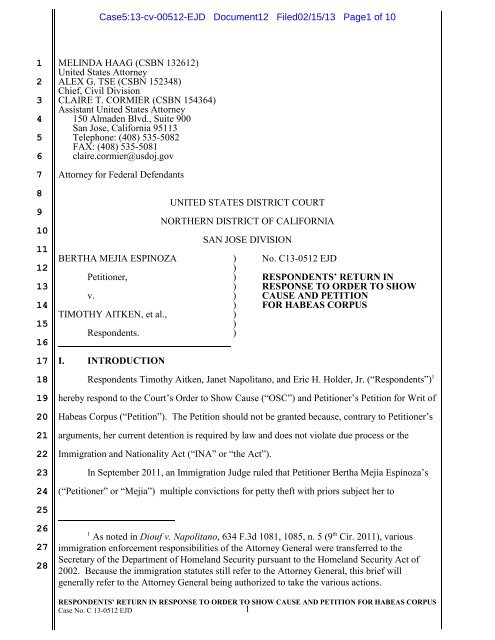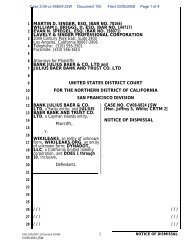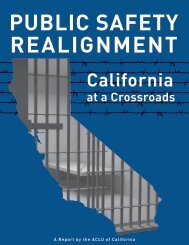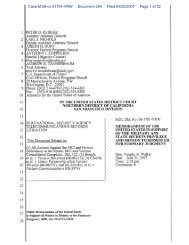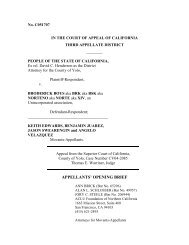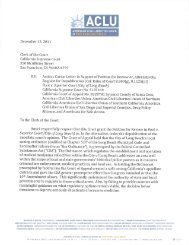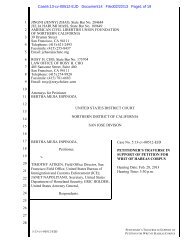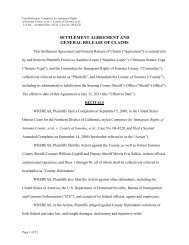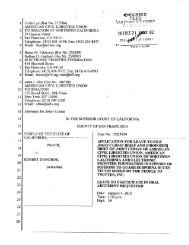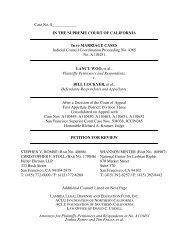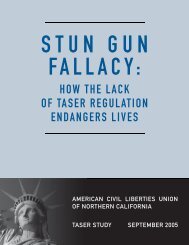Respondents Return in Response to Order to Show Cause
Respondents Return in Response to Order to Show Cause
Respondents Return in Response to Order to Show Cause
You also want an ePaper? Increase the reach of your titles
YUMPU automatically turns print PDFs into web optimized ePapers that Google loves.
Case5:13-cv-00512-EJD Document12 Filed02/15/13 Page1 of 10123456789101112131415161718192021222324MELINDA HAAG (CSBN 132612)United States At<strong>to</strong>rneyALEX G. TSE (CSBN 152348)Chief, Civil DivisionCLAIRE T. CORMIER (CSBN 154364)Assistant United States At<strong>to</strong>rney150 Almaden Blvd., Suite 900San Jose, California 95113Telephone: (408) 535-5082FAX: (408) 535-5081claire.cormier@usdoj.govAt<strong>to</strong>rney for Federal DefendantsBERTHA MEJIA ESPINOZAPetitioner,v.TIMOTHY AITKEN, et al.,<strong>Respondents</strong>.I. INTRODUCTIONUNITED STATES DISTRICT COURTNORTHERN DISTRICT OF CALIFORNIASAN JOSE DIVISION)))))))))No. C13-0512 EJDRESPONDENTS’ RETURN INRESPONSE TO ORDER TO SHOWCAUSE AND PETITIONFOR HABEAS CORPUS<strong>Respondents</strong> Timothy Aitken, Janet Napolitano, and Eric H. Holder, Jr. (“<strong>Respondents</strong>”) 1hereby respond <strong>to</strong> the Court’s <strong>Order</strong> <strong>to</strong> <strong>Show</strong> <strong>Cause</strong> (“OSC”) and Petitioner’s Petition for Writ ofHabeas Corpus (“Petition”). The Petition should not be granted because, contrary <strong>to</strong> Petitioner’sarguments, her current detention is required by law and does not violate due process or theImmigration and Nationality Act (“INA” or “the Act”).In September 2011, an Immigration Judge ruled that Petitioner Bertha Mejia Esp<strong>in</strong>oza’s(“Petitioner” or “Mejia”) multiple convictions for petty theft with priors subject her <strong>to</strong>252627281 thAs noted <strong>in</strong> Diouf v. Napolitano, 634 F.3d 1081, 1085, n. 5 (9 Cir. 2011), variousimmigration enforcement responsibilities of the At<strong>to</strong>rney General were transferred <strong>to</strong> theSecretary of the Department of Homeland Security pursuant <strong>to</strong> the Homeland Security Act of2002. Because the immigration statutes still refer <strong>to</strong> the At<strong>to</strong>rney General, this brief willgenerally refer <strong>to</strong> the At<strong>to</strong>rney General be<strong>in</strong>g authorized <strong>to</strong> take the various actions.RESPONDENTS’ RETURN IN RESPONSE TO ORDER TO SHOW CAUSE AND PETITION FOR HABEAS CORPUSCase No. C 13-0512 EJD 1
Case5:13-cv-00512-EJD Document12 Filed02/15/13 Page2 of 10123456789101112131415161718192021222324252627282manda<strong>to</strong>ry detention under INA §236(c)(1)(A) (codified at 8 U.S.C. §1226(c)) for be<strong>in</strong>g<strong>in</strong>admissible as an alien who has been convicted of a crime <strong>in</strong>volv<strong>in</strong>g moral turpitude. She hasnow been <strong>in</strong> cus<strong>to</strong>dy approximately 16 months. Petitioner asks this Court <strong>to</strong> order herimmediate release or “order a constitutionally adequate hear<strong>in</strong>g before an Immigration Judge.”Though there are many issues relat<strong>in</strong>g <strong>to</strong> Mejia’s immigration status, the only issue before thisCourt is whether her current detention is lawful.Federal immigration statutes classify non-citizens <strong>in</strong><strong>to</strong> different groups. Theseclassifications matter. An alien’s classification makes “all the difference” <strong>in</strong> terms of whether,when, under what standard, and <strong>in</strong> what forum an alien may challenge his detention. Zadvydas v.Davis, 533 U.S. 678, 693 (2001). “Where an alien falls with<strong>in</strong> this statu<strong>to</strong>ry scheme can affectwhether his detention is manda<strong>to</strong>ry or discretionary, as well as the k<strong>in</strong>d of review processavailable <strong>to</strong> him if he wishes <strong>to</strong> contest the necessity of his detention.” Prie<strong>to</strong>-Romero v. Clark,534 F.3d 1053, 1057-58 (9th Cir. 2008).Petitioner <strong>in</strong> this case is an alien, who has never received lawful permanent resident3status, who has been convicted of a crime <strong>in</strong>volv<strong>in</strong>g moral turpitude and is thus <strong>in</strong>admissible.Under such circumstances, the law requires that she be taken <strong>in</strong><strong>to</strong> cus<strong>to</strong>dy. See 8 U.S.C. §1226(c) (“The At<strong>to</strong>rney General shall take <strong>in</strong><strong>to</strong> cus<strong>to</strong>dy” such aliens.).The Petition was filed on February 6, 2013. On the same date, this Court issued an <strong>Order</strong><strong>to</strong> <strong>Show</strong> <strong>Cause</strong> requir<strong>in</strong>g <strong>Respondents</strong> <strong>to</strong> file a return with<strong>in</strong> three days of the service of theorder, and requir<strong>in</strong>g Petitioner <strong>to</strong> file a reply or traverse with<strong>in</strong> three days thereafter. OnFebruary 7, 2013, the parties submitted a stipulation request<strong>in</strong>g modifications <strong>to</strong> that schedule.The Court agreed and issued an order giv<strong>in</strong>g <strong>Respondents</strong> until February 15, 2003 <strong>to</strong> file theirreturn, and giv<strong>in</strong>g Petitioner until February 22, 2013 <strong>to</strong> file a reply or traverse.2<strong>Respondents</strong> will use the United States Code citations <strong>to</strong> the INA. Unless otherwisenoted, statu<strong>to</strong>ry references here<strong>in</strong> will be <strong>to</strong> Title 8 of the United States Code.3Petitioner does not seem <strong>to</strong> contest that her multiple crim<strong>in</strong>al convictions place her <strong>in</strong>the category of aliens described <strong>in</strong> §1226(c)(1)(A). Instead, she challenges the validity andconstitutionality of the manda<strong>to</strong>ry detention process, whether the At<strong>to</strong>rney General <strong>to</strong>ok her <strong>in</strong><strong>to</strong>cus<strong>to</strong>dy at the time allowed under the statute, and whether she should be excused from theprovision of § 1226(c) because, ultimately, she might not be removed.RESPONDENTS’ RETURN IN RESPONSE TO ORDER TO SHOW CAUSE AND PETITION FOR HABEAS CORPUSCase No. C 13-0512 EJD 2
Case5:13-cv-00512-EJD Document12 Filed02/15/13 Page3 of 1012II.STATEMENT OF FACTSAs noted above, <strong>in</strong> September 2011, an Immigration Judge ruled that Mejia’s multiple34567891011121314151617181920212223convictions for petty theft with priors subject her <strong>to</strong> manda<strong>to</strong>ry detention under INA§236(c)(1)(A) for be<strong>in</strong>g <strong>in</strong>admissible as an alien who has been convicted of a crime <strong>in</strong>volv<strong>in</strong>gmoral turpitude. Petition 20. Mejia filed motions for bond redeterm<strong>in</strong>ation on Oc<strong>to</strong>ber 18,2012 and aga<strong>in</strong> on December 20, 2012. Petition 26. The Immigration Judge denied themotions on Oc<strong>to</strong>ber 23, 2012 and January 14, 2013, respectively. Declaration of Rosy H. Cho <strong>in</strong>Support of Petition for Writ of Habeas Corpus (“Cho Decl.”) Ex. G and H. Mejia asserts that sheshould have received a bond hear<strong>in</strong>g.In the meantime, Mejia has cont<strong>in</strong>ued <strong>in</strong> her attempts <strong>to</strong> secure withhold<strong>in</strong>g of removal4and/or change of status through the U visa process.On or about January 3, 2012, through her previous at<strong>to</strong>rney, Mejia submitted a U visaapplication. Cho Decl. 5. On August 28, 2012, an Immigration Judge denied Mejia’sapplication for asylum and withhold<strong>in</strong>g of removal and ordered her removal <strong>to</strong> El Salvador.Petition 22. The respondent appealed this decision <strong>to</strong> the Board of Immigration Appeals(“BIA”). Petition 24. Mejia’s application for a U visa was denied by United StatesCitizenship and Immigration Services (“USCIS”) on or about November 7, 2012. Petition 23.On or about December 15, 2012, through her current at<strong>to</strong>rney, Mejia submitted a renewed U visaapplication. Petition 25. On January 11, 2013, the BIA issued an order remand<strong>in</strong>g Petitioner’scase <strong>to</strong> an Immigration Judge “<strong>to</strong> ascerta<strong>in</strong> the status of her application for U visa non-immigrantstatus, and if appropriate, determ<strong>in</strong>e whether she has established good cause for a cont<strong>in</strong>uance <strong>to</strong>await adjudication of such application by [USCIS].” Petition 25 and Declaration of Claire T.Cormier (“Cormier Decl.”) 4 and Ex. 1. On or about February 1, 2013, USCIS granted24252627284Pursuant <strong>to</strong> 8 C.F.R. § 214.14, an undocumented alien is eligible for U–1 nonimmigrantstatus if, among other th<strong>in</strong>gs, she is the victim of rape or other qualify<strong>in</strong>g crim<strong>in</strong>al activity tha<strong>to</strong>ccurred <strong>in</strong> the United States, and cooperates <strong>in</strong> the prosecution of the crime. For a discussion ofthe statu<strong>to</strong>ry and regula<strong>to</strong>ry background of the “U” nonimmigrant classification, see CatholicCharities CYO v. Cher<strong>to</strong>ff, 622 F.Supp.2d 865, 870 (N.D.Cal. 2008), aff'd sub nom. CatholicCharities CYO v. Napolitano, 368 Fed. Appx. 750 (9th Cir. 2010).RESPONDENTS’ RETURN IN RESPONSE TO ORDER TO SHOW CAUSE AND PETITION FOR HABEAS CORPUSCase No. C 13-0512 EJD 3
Case5:13-cv-00512-EJD Document12 Filed02/15/13 Page4 of 10123456expedited process<strong>in</strong>g of her U visa application and determ<strong>in</strong>ed her <strong>to</strong> be prima facie eligible forU nonimmigrant classification pursuant <strong>to</strong> 8 C.F.R. 214.14(b). Cormier Decl. 3 and 5 and Ex.2. That eligibility classification expires on the earliest of: 1) its revocation, 2) a f<strong>in</strong>al decision onher U visa application, or 3) July 31, 2013. Cormier Decl Ex. 2. Mejia is scheduled for a hear<strong>in</strong>gbefore an Immigration Judge on March 26, 2013. Cormier Decl. 6 and Ex. 3. In the meantime,she rema<strong>in</strong>s deta<strong>in</strong>ed pursuant <strong>to</strong> § 1226(c).78III.ARGUMENTPetitioner is classified under federal immigration law as a crim<strong>in</strong>al alien. As such, she is910111213141516171819202122232425considered <strong>in</strong>admissible pursuant <strong>to</strong> 8 U.S.C. § 1182(a)(2). Such aliens “shall” be taken <strong>in</strong><strong>to</strong>cus<strong>to</strong>dy and can be released only under certa<strong>in</strong> very limited circumstances which do not applyhere. 8 U.S.C. §1226(c). This is different from the discretionary detention rules applicable <strong>to</strong>aliens arrested and deta<strong>in</strong>ed pursuant <strong>to</strong> warrants issued by the At<strong>to</strong>rney General, or aliens whohave received a f<strong>in</strong>al order of removal. See 8 U.S.C. § 1226(a) and 8 U.S.C. § 1231(a)(6). Thestatute expressly states that “[n]o court may set aside any action or decision by the At<strong>to</strong>rneyGeneral under this section regard<strong>in</strong>g the detention or release of any alien or the grant, revocation,5or denial of bond or parole.” 8 U.S.C. § 1226(e).A. Section 1226(c) constitutionally mandates Petitioner’s detention dur<strong>in</strong>g thependency of her removal proceed<strong>in</strong>gs.Petitioner argues that neither the statute nor the Constitution authorize the At<strong>to</strong>rneyGeneral <strong>to</strong> hold her <strong>in</strong> prolonged detention without afford<strong>in</strong>g her a bond hear<strong>in</strong>g at which thegovernment must “prove by clear and conv<strong>in</strong>c<strong>in</strong>g evidence that she is either a flight risk or adanger <strong>to</strong> the community.” Petition 29. Section 1226(c) does not expressly limit the length ofthe detention for crim<strong>in</strong>al aliens.The Supreme Court has ruled that the manda<strong>to</strong>ry detention provision of § 1226(c) – i.e.,“detention of deportable crim<strong>in</strong>al aliens pend<strong>in</strong>g their removal proceed<strong>in</strong>gs” – is constitutional.2627285The Supreme Court has held that district courts do have jurisdiction over habeaspetitions challeng<strong>in</strong>g the statu<strong>to</strong>ry framework of § 1226(c), but not challenges <strong>to</strong> discretionarydecisions of the At<strong>to</strong>rney General with<strong>in</strong> that framework. Demore v. Kim, 538 U.S. 510, 516-517 (2003).RESPONDENTS’ RETURN IN RESPONSE TO ORDER TO SHOW CAUSE AND PETITION FOR HABEAS CORPUSCase No. C 13-0512 EJD 4
Case5:13-cv-00512-EJD Document12 Filed02/15/13 Page5 of 10123456789101112131415161718192021222324252627Demore v. Kim, 538 U.S. 510, 527-528 (2003) (emphasis <strong>in</strong> orig<strong>in</strong>al). The Court dist<strong>in</strong>guishedits prior decision <strong>in</strong> Zadvydas v. Davis, 533 U.S. 678 (2001), which related <strong>to</strong> detention of aliensunder 8 U.S.C. § 1231, which governs detention follow<strong>in</strong>g a f<strong>in</strong>al order of removal. Demore,538 U.S. at 526-527. “[P]ost removal-period detention, unlike detention pend<strong>in</strong>g adeterm<strong>in</strong>ation of removability . . ., has no obvious term<strong>in</strong>ation po<strong>in</strong>t.” Id. at 529 (emphasis <strong>in</strong>orig<strong>in</strong>al), quot<strong>in</strong>g Zadvydas, 533 U.S. at 697. The Supreme Court did note that most cases ofdetention dur<strong>in</strong>g removal proceed<strong>in</strong>gs last shorter times than Petitioner’s detention here, but itdid not set a numerical limit on the permissible length of detention dur<strong>in</strong>g such proceed<strong>in</strong>gs. Seeid. at 530-531. Instead, it held that “[d]etention dur<strong>in</strong>g removal proceed<strong>in</strong>gs is a constitutionallypermissible part of” the removal process. Id. at 531.Petitioner argues that the “N<strong>in</strong>th Circuit has repeatedly construed immigration detentionstatutes as implicitly provid<strong>in</strong>g for bond hear<strong>in</strong>gs <strong>to</strong> avoid the due process concerns otherwiseposed by prolonged detention.” Petition 31. None of Petitioner’s cited cases discuss thesituation before the Court now: a crim<strong>in</strong>al alien, who has never had lawful permanent residentstatus, who is deta<strong>in</strong>ed dur<strong>in</strong>g the pendency of her removal proceed<strong>in</strong>gs.Petitioner cites <strong>to</strong> Tijani v. Willis, 430 F.3d 1241, 1242 (9th Cir. 2005), for theproposition that manda<strong>to</strong>ry detention is authorized only dur<strong>in</strong>g “expeditious removalproceed<strong>in</strong>gs” and thus a bond hear<strong>in</strong>g was required for a petitioner who had been deta<strong>in</strong>ed forover two and a half years. The N<strong>in</strong>th Circuit, <strong>in</strong> its very short majority op<strong>in</strong>ion, found that it was“constitutionally doubtful that Congress may authorize imprisonment of this duration for lawfullyadmitted resident aliens who are subject <strong>to</strong> removal.” Id. at 1242 (emphasis added). Though themajority op<strong>in</strong>ion provides virtually no factual background or analysis, it appears from theconcurr<strong>in</strong>g op<strong>in</strong>ion that, while the case is discussed <strong>in</strong> terms of detention under §1226(c), Tijaniactually had progressed past a f<strong>in</strong>al removal order. Id. at 1246, 1248, n. 7. (not<strong>in</strong>g that Tijani hada petition for review of the removal order pend<strong>in</strong>g before the N<strong>in</strong>th Circuit and that he hadalready received a BIA decision f<strong>in</strong>d<strong>in</strong>g him removable). In contrast, Mejia is not a lawfulpermanent resident, and her removal proceed<strong>in</strong>gs are still <strong>in</strong> progress before the agency.28RESPONDENTS’ RETURN IN RESPONSE TO ORDER TO SHOW CAUSE AND PETITION FOR HABEAS CORPUSCase No. C 13-0512 EJD 5
Case5:13-cv-00512-EJD Document12 Filed02/15/13 Page6 of 1012345678910111213141516171819202122232425262728Petitioner also cites <strong>to</strong> Casas-Castrillon v. Department of Homeland Security, 535 F.3d942 (9th Cir. 2008), argu<strong>in</strong>g that it construes § 1226(c) “as apply<strong>in</strong>g only <strong>to</strong> expeditious removalproceed<strong>in</strong>gs because ‘prolonged detention without adequate procedural protections would raiseserious constitutional concerns.’” Petition 32. However, though the petitioner <strong>in</strong> Casas-Castrillon had been deta<strong>in</strong>ed dur<strong>in</strong>g removal proceed<strong>in</strong>gs pursuant <strong>to</strong> § 1226(c), the N<strong>in</strong>thCircuit decision related <strong>to</strong> his cont<strong>in</strong>ued detention after his removal order had been affirmed bythe BIA, and thus “the basis for his detention shifted from § 1226(c) <strong>to</strong> 1226(a), under which hewas entitled <strong>to</strong> a bond hear<strong>in</strong>g.” Petition 32, cit<strong>in</strong>g Casas-Castrillon at 948. See also Zadvydasv. Davis, 533 U.S. 678 (2001) (discuss<strong>in</strong>g limits on detentions after a f<strong>in</strong>al removal order). Inaddition, Casas-Castrillon was a lawful permanent resident. 535 F.3d at 944. Casas-Castrillonnoted that, at the time the petitioner filed his habeas petition, his adm<strong>in</strong>istrative proceed<strong>in</strong>gs hadbeen complete for approximately three years. Id. at 945. The N<strong>in</strong>th Circuit further stated that,“[o]nce Casas’ proceed<strong>in</strong>gs before the BIA were complete, the At<strong>to</strong>rney General’s authority <strong>to</strong>deta<strong>in</strong> him under § 1226(c) ended and that authority shifted <strong>in</strong>stead <strong>to</strong> § 1226(a).” Id. at 948.This rema<strong>in</strong>ed true even after the N<strong>in</strong>th Circuit remanded the case back <strong>to</strong> the agency. However,the N<strong>in</strong>th Circuit concluded that “the manda<strong>to</strong>ry, bureaucratic detention of aliens under § 1226(c)was <strong>in</strong>tended <strong>to</strong> apply for only a limited time and ended <strong>in</strong> this case when the BIA affirmedCasas’ order of removal <strong>in</strong> July 2002,” at which time he had been deta<strong>in</strong>ed for almost a year. Id.at 944, 948. It also noted that “[s]ection 1226(a), unlike § 1226(c), provides such authority forthe At<strong>to</strong>rney General <strong>to</strong> conduct a bond hear<strong>in</strong>g and release the alien on bond or deta<strong>in</strong> him ifnecessary <strong>to</strong> secure his presence at removal.” Id. at 951 (emphasis added).Here, Mejia, who is not a lawful permanent resident, is still <strong>in</strong> removal proceed<strong>in</strong>gs. TheBIA has remanded the matter <strong>to</strong> an Immigration Judge <strong>to</strong> make a determ<strong>in</strong>ation on her U visaapplication. Had Mejia been a lawful permanent resident, and had the BIA affirmed the previousdecision by the Immigration Judge <strong>to</strong> remove Mejia <strong>in</strong>stead of remand<strong>in</strong>g for furtherproceed<strong>in</strong>gs, Casas-Castrillon might apply, but it does not under these circumstances.Mejia also argues that Diouf v. Napolitano, 634 F.3d 1081, 1091-92 (9th Cir. 2011),holds that a detention becomes “prolonged” at six months, and that a bond hear<strong>in</strong>g is thenRESPONDENTS’ RETURN IN RESPONSE TO ORDER TO SHOW CAUSE AND PETITION FOR HABEAS CORPUSCase No. C 13-0512 EJD 6
Case5:13-cv-00512-EJD Document12 Filed02/15/13 Page7 of 1012345678910111213141516171819202122232425262728required. Petition 33. However, as with Casas-Castrillon and Zadvydas, the detention at issue<strong>in</strong> Diouf was after a f<strong>in</strong>al order of removal; <strong>in</strong> Diouf, it was detention under § 1231(a)(6). Dioufalso noted that, when the N<strong>in</strong>th Circuit had reviewed Diouf’s prior habeas petition, it found thathis “detention was authorized by statute because, although it was prolonged, it was not<strong>in</strong>def<strong>in</strong>ite.” Id. at 1084. Diouf also noted that detention dur<strong>in</strong>g the period “pend<strong>in</strong>g a decision onwhether the alien is <strong>to</strong> be removed” is manda<strong>to</strong>ry for crim<strong>in</strong>al aliens under § 1226(c) (such asMejia). Id. at 1084-1085, and n. 4.Similarly, <strong>in</strong> S<strong>in</strong>gh v. Holder, 638 F.3d 1196 (9th Cir. 2011), a lawful permanent residenthad received a f<strong>in</strong>al order of removal, affirmed by the BIA, for which he petitioned for review <strong>to</strong>the N<strong>in</strong>th Circuit. Id. at 1200-1201. Accord<strong>in</strong>gly, he received a bond hear<strong>in</strong>g, referred <strong>to</strong> as a“Casas bond hear<strong>in</strong>g,” the result of which he was challeng<strong>in</strong>g. Id. In decid<strong>in</strong>g <strong>to</strong> remand for anew Casas bond hear<strong>in</strong>g, the N<strong>in</strong>th Circuit noted that “all deta<strong>in</strong>ees afforded Casas bondhear<strong>in</strong>gs . . . [have] already been ordered removed by a f<strong>in</strong>al, adm<strong>in</strong>istrative order.” Id. at 1205.There has been no such f<strong>in</strong>al, adm<strong>in</strong>istrative order <strong>in</strong> the <strong>in</strong>stant case.Thus, <strong>in</strong> Zadvydas, Tijani, Casas-Castrillon, Diouf, and S<strong>in</strong>gh, the petitioner hadcompleted adm<strong>in</strong>istrative removal proceed<strong>in</strong>gs prior <strong>to</strong> challeng<strong>in</strong>g cont<strong>in</strong>ued detention, and thecourts have noted that this dist<strong>in</strong>ction, between detention before versus after a f<strong>in</strong>al removalorder, is a dist<strong>in</strong>ction with a difference. After a f<strong>in</strong>al removal order, there is no event (other thanactual removal or a lengthy petition for review <strong>to</strong> the N<strong>in</strong>th Circuit) that is anticipated <strong>to</strong> changethe petitioner’s immigration situation. There is no end <strong>in</strong> sight. In contrast, when removalproceed<strong>in</strong>gs are still underway, as they are here, there are procedures that will lead <strong>to</strong> a f<strong>in</strong>aldecision. In some <strong>in</strong>stances, that takes a significant amount of time. When that f<strong>in</strong>al decision isreached, then restrictions on detention may apply. But Petitioner has cited <strong>to</strong> no Supreme Cour<strong>to</strong>r Circuit Court decision requir<strong>in</strong>g bond hear<strong>in</strong>gs dur<strong>in</strong>g the manda<strong>to</strong>ry detention of § 1226(c)prior <strong>to</strong> a f<strong>in</strong>al order of removal. 66Petitioner also cites <strong>to</strong> Rodriguez v. Robb<strong>in</strong>s, No. CV-07-03239 TJH-RNB (C.D. Cal.,filed May 16, 2007), a case <strong>in</strong>volv<strong>in</strong>g the issuance of an unprecedented <strong>in</strong>junction requir<strong>in</strong>g ICE<strong>to</strong> provide bond hear<strong>in</strong>gs <strong>to</strong> essentially all non-citizens <strong>in</strong> removal proceed<strong>in</strong>gs <strong>in</strong> the CentralRESPONDENTS’ RETURN IN RESPONSE TO ORDER TO SHOW CAUSE AND PETITION FOR HABEAS CORPUSCase No. C 13-0512 EJD 7
Case5:13-cv-00512-EJD Document12 Filed02/15/13 Page8 of 10123456789101112Petitioner next argues that § 1226(c) violates the Due Process Clause of the Constitution.Petitioner has cited <strong>to</strong> no authorities support<strong>in</strong>g this view under circumstances like those <strong>in</strong> the<strong>in</strong>stant case. In any event, the Supreme Court has already ruled on the constitutionality of thestatute. See Demore v. Kim, 538 U.S. 510 (2003). See also Rodriguez v. Hayes, 578 F.3d 10321043 (9th Cir. 2009), cit<strong>in</strong>g Demore (“The Supreme Court has held that detention pursuant <strong>to</strong>Section 1226(c) does not raise any due process concerns.”).B. Section 1226(c) does not require immediate detention after release fromcrim<strong>in</strong>al cus<strong>to</strong>dy.Petitioner argues that the “when. . . released” language <strong>in</strong> § 1226(c) means that the alienmust have been taken <strong>in</strong><strong>to</strong> ICE cus<strong>to</strong>dy immediately upon or very shortly after release fromcrim<strong>in</strong>al cus<strong>to</strong>dy. The only Circuit <strong>to</strong> rule on this issue has held that this is not the mean<strong>in</strong>g ofthe statute. See Hosh v. Lucero, 680 F.3d 375 (4th Cir. 2012), cit<strong>in</strong>g Matter of Rojas, 23 I&N13141516171819202122232425262728District of California. The long procedural his<strong>to</strong>ry of that case is <strong>in</strong>structive. In March 2008, thedistrict court denied class certification <strong>in</strong> the case without explanation. Rodriguez v. Hayes, 591F.3d.1105, 1111 (9th Cir. 2010). In the absence of a reasoned decision, the N<strong>in</strong>th Circuitreviewed the district court’s rul<strong>in</strong>g de novo and reversed, hold<strong>in</strong>g that class treatment waswarranted <strong>to</strong> ensure uniform treatment of deta<strong>in</strong>ed aliens. Id. at 1126. In do<strong>in</strong>g so, however, theN<strong>in</strong>th Circuit recognized that some of the class members might be “properly subject <strong>to</strong>manda<strong>to</strong>ry detention and that the regulations currently implement<strong>in</strong>g the various discretionarydetention statutes provide for a different burden of proof at bond hear<strong>in</strong>gs.” Id. at 1125(observ<strong>in</strong>g that “class members may have suffered no <strong>in</strong>jury or different <strong>in</strong>juries” due <strong>to</strong> aliens’different immigration statuses). Accord<strong>in</strong>gly, the N<strong>in</strong>th Circuit remanded the case for the districtcourt <strong>to</strong> consider, among other th<strong>in</strong>gs, “whether formation of subclasses would be appropriate” <strong>in</strong>light of the different statu<strong>to</strong>ry and constitutional standards applicable <strong>to</strong> different members of thecertified class. Id. at 1126. On remand, contrary <strong>to</strong> the N<strong>in</strong>th Circuit’s guidance, the districtcourt issued an order certify<strong>in</strong>g a s<strong>in</strong>gle, unified class effectively encompass<strong>in</strong>g every deta<strong>in</strong>edalien <strong>in</strong> the Central District. It also issued a prelim<strong>in</strong>ary <strong>in</strong>junction and, with no analysis <strong>to</strong>expla<strong>in</strong> its decision, granted sweep<strong>in</strong>g habeas relief compell<strong>in</strong>g ICE <strong>to</strong> provide a bond hear<strong>in</strong>gbefore an Immigration Judge for any alien after six months of detention. Rodriguez v. Robb<strong>in</strong>s,No. CV-07-03239 TJH-RNB, Docket No. 255. That <strong>in</strong>junction would encompass even thepetitioner <strong>in</strong> Demore v. Kim, whom the Supreme Court held was not entitled <strong>to</strong> such relief. TheCentral District’s decision has been appealed on an expedited schedule and is set for hear<strong>in</strong>g nextmonth. See Rodriguez v. Robb<strong>in</strong>s, No. 12-56734 (filed <strong>in</strong> N<strong>in</strong>th Circuit on November 21, 2012).<strong>Respondents</strong> submit that the Central District’s order <strong>in</strong> Rodriguez should be given no weights<strong>in</strong>ce it is contrary <strong>to</strong> Supreme Court precedent and offers no analysis for this Court <strong>to</strong> consider.RESPONDENTS’ RETURN IN RESPONSE TO ORDER TO SHOW CAUSE AND PETITION FOR HABEAS CORPUSCase No. C 13-0512 EJD 8
Case5:13-cv-00512-EJD Document12 Filed02/15/13 Page9 of 1012345678910111213141516171819202122232425262728Dec. 117 (BIA 2001). In Hosh, the alien had been out of actual crim<strong>in</strong>al cus<strong>to</strong>dy for over threeyears at the time that he was deta<strong>in</strong>ed. Hosh found the language of the statute <strong>to</strong> be susceptible <strong>to</strong>more than one <strong>in</strong>terpretation and thus gave deference <strong>to</strong> the BIA’s <strong>in</strong>terpretation that crim<strong>in</strong>alaliens are subject <strong>to</strong> manda<strong>to</strong>ry detention “despite not hav<strong>in</strong>g been deta<strong>in</strong>ed immediately uponrelease from state cus<strong>to</strong>dy.” Id. at 380. Hosh was aware that district courts around the country,<strong>in</strong>clud<strong>in</strong>g this district, had reached differ<strong>in</strong>g conclusions on the mean<strong>in</strong>g of this language <strong>in</strong> §1226(c), but nevertheless found the BIA’s <strong>in</strong>terpretation <strong>to</strong> be reasonable. Hosh also noted that,even if the statute were <strong>to</strong> be read <strong>to</strong> require ICE <strong>to</strong> take immediate cus<strong>to</strong>dy of such crim<strong>in</strong>alaliens, such noncompliance “does not bes<strong>to</strong>w a w<strong>in</strong>dfall upon crim<strong>in</strong>al aliens” and, therefore,Hosh rema<strong>in</strong>ed subject <strong>to</strong> manda<strong>to</strong>ry detention. Id. at 384.Here, Petitioner compla<strong>in</strong>s that she has been deta<strong>in</strong>ed for <strong>to</strong>o long under § 1226(c), butargues that she can’t be deta<strong>in</strong>ed under that statute at all because ICE did not beg<strong>in</strong> her detentiona year earlier. This is not the law.C. Petitioner’s pend<strong>in</strong>g visa application does not excuse her from manda<strong>to</strong>rydetention.Mejia argues that she is not subject <strong>to</strong> manda<strong>to</strong>ry detention under § 1226(c) because sheis eligible for a U visa and therefore is not “<strong>in</strong>admissible” or “deportable.” She says that thestatute should not apply <strong>to</strong> noncitizens who have “a substantial claim for relief from removal.”Mejia’s removal has not yet been decided. If ultimately she is not removed, she will bereleased from detention. However, if the f<strong>in</strong>al decision is removal, then detention will do exactlywhat it is supposed <strong>to</strong> do – allow ICE easy access <strong>to</strong> her for deportation.D. If the Court grants any relief, immediate release would be improper.Though Mejia’s Petition should be denied <strong>in</strong> its entirety for the reasons stated above,should the Court disagree and be <strong>in</strong>cl<strong>in</strong>ed <strong>to</strong> grant some relief, it should not be the immediaterelease sought by Petitioner. Mejia seems <strong>to</strong> understand that immediate release would be<strong>in</strong>appropriate, s<strong>in</strong>ce she has alternatively requested a bond hear<strong>in</strong>g.Mejia compla<strong>in</strong>s that she has not received a bond hear<strong>in</strong>g at which a proper determ<strong>in</strong>ationcould be made as <strong>to</strong> whether she should rema<strong>in</strong> <strong>in</strong> cus<strong>to</strong>dy. Were she entitled <strong>to</strong> such a bondRESPONDENTS’ RETURN IN RESPONSE TO ORDER TO SHOW CAUSE AND PETITION FOR HABEAS CORPUSCase No. C 13-0512 EJD 9
Case5:13-cv-00512-EJD Document12 Filed02/15/13 Page10 of 1012345678910hear<strong>in</strong>g (which she is not), the At<strong>to</strong>rney General would still have discretion <strong>to</strong> make a decisionbased on the evidence at hand. Such a decision, presum<strong>in</strong>g a constitutional process, would notbe subject <strong>to</strong> judicial review. 8 U.S.C. § 1226(e) (“No court may set aside any action or decisionby the At<strong>to</strong>rney General under this section regard<strong>in</strong>g the detention or release of any alien or thegrant, revocation, or denial of bond or parole.”). See also S<strong>in</strong>gh v. Holder, 638 F.3d 1196, 1202(9th Cir. 2011) (not<strong>in</strong>g that the At<strong>to</strong>rney General’s “discretionary judgment . . . shall not besubject <strong>to</strong> review,” even if there can be review of claims that the process itself wasconstitutionally flawed).Accord<strong>in</strong>gly, should the Court decide <strong>to</strong> order any relief, immediate release of thePetitioner would be <strong>in</strong>appropriate.1112IV.CONCLUSIONSection 1226(c) requires the detention of crim<strong>in</strong>al aliens dur<strong>in</strong>g their removal proceed<strong>in</strong>gs13141516171819202122with no discretion for release on bond except <strong>in</strong> very limited circumstances not found here. Itdoes not place a time limit on such detention, presumably because detention proceed<strong>in</strong>gs do,eventually, end. Mejia has received all the process that she is due. In addition, as held by theFourth Circuit, ICE was not required <strong>to</strong> take her <strong>in</strong><strong>to</strong> cus<strong>to</strong>dy immediately upon her release fromcrim<strong>in</strong>al cus<strong>to</strong>dy. F<strong>in</strong>ally, while it is true that the possibility exists that, at the end of herproceed<strong>in</strong>gs, Mejia may not be removed, that prospect does not require her release now.Mejia’s petition for habeas corpus should be denied. Should the Court for any reason be<strong>in</strong>cl<strong>in</strong>ed <strong>to</strong> grant her relief, immediate release would be <strong>in</strong>appropriate. If the Court f<strong>in</strong>ds she isentitled <strong>to</strong> any relief, it should be a bond hear<strong>in</strong>g pursuant <strong>to</strong> 8 U.S.C. § 1226(a).Respectfully submitted,2324252627DATED: February 15, 2013MELINDA HAAGUnited States At<strong>to</strong>rney/s/ Claire T. CormierCLAIRE T. CORMIERAssistant United States At<strong>to</strong>rney28RESPONDENTS’ RETURN IN RESPONSE TO ORDER TO SHOW CAUSE AND PETITION FOR HABEAS CORPUSCase No. C 13-0512 EJD 10


